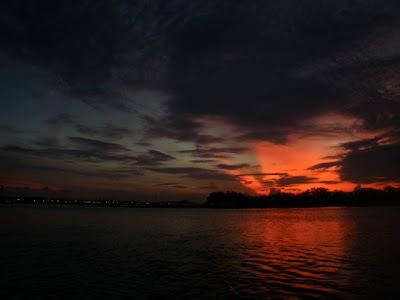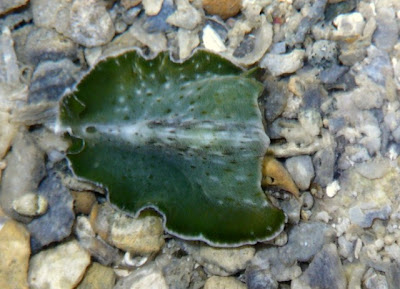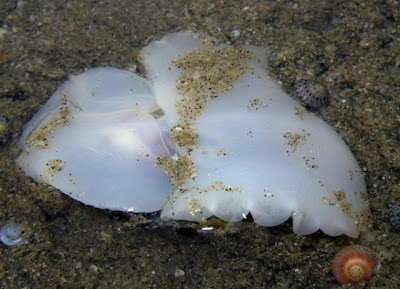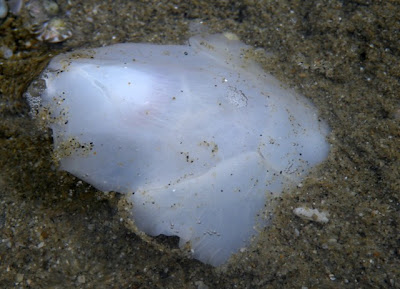My many firsts today!
My first morning trip of 2009.
My first visit to Terumbu Raya- which is translated as Great Reef. :-)
My first time seeing some critters which I will share with you all later.
I'm glad to visit one more patch reef which I've blogged about previously. Wasn't supposed to come as my thesis is running out of time. But Termubu Raya is just too hard to resist!
It's always a drag to wake up at unearthly hours. The sun only just rose after we reach Terumbu Raya, a patch reef off the intertidal area of Pulau Semakau. The glow and rays from the sunrise was spectacular.
Very soon, light filled the skies and here we are presenting to you Terumbu Raya!
Just upon stepping on this great reef, I saw the my first Fire anemone (Actinodendron sp.). Like fireworms as the name suggest, you won't want to touch them.
I like the white lines radiating outwards on its oral disk.
I showed the fire anemone to Alicia and Stephen and they pointed out the octopus just beside the anemone! I was probably just too engrossed with the fire anemone.
Alicia had a keen eye and she spotted several creatures. She later showed me this bluish green thing that looks like seaweed. Wonder what is its species.
Low tide timing was short. For today, I focused on the reef edge.
I was stunned to see a huge array of coral reef. What amazes me is the clear water. I could see the edge and reef slope pretty clear. I am really very tempted to dive or snorkel!
Chay Hoon says that her dive at Hantu yesterday was an incredible 10m visibility!
There were several sponges that should be barrel sponges.
I heard that the Neptune's cup sponge has not been recorded in Singapore for a long time. So therefore, these should be barrel sponges. But this one was quite big, about 20cm in diameter.
There are also other orange sponges that is more horn-shaped like.
Termubu Raya has many types of anemones according to their previous trip.
At the reef edge, the Bubble-tip sea anemone (Entacmea quadricolor) is not difficult to find. This one has a white ring near its tip.
Whereas this one has a green tip. Unfortunately, no associate tomato clownfishes were sighted.
At another part of the reef edge, I found this showy and attractive looking anemone. It just defies my concept of anemones as it is neon yellow and pink!
A closer look reveals that it is a Pizza anemone (Cryptodendrum adhaesivum). I don't think such a bright pizza anemone has been seen before.
Another anemone that I've spotted is this wriggly sea anemone that we still don't know its identification. While photographing this anemone, my eyesight became macro for a moment...
and I saw this tiny 1-cm nudibranch! My first time seeing this Chromodoris Fidelis which is usually only sighted during dives.
Terumbu Raya is a great place for nudibranch and I later saw this Phyllid nudibranch (Phyllidiella pustulosa). The blue colour is nice.
Chay Hoon spotted this commonly sighted Polka-dot nudibranch (Jorunna funebris) which is also known as the oreo slug.
Soon, Chay Hoon found for me yet another special find! Another of my first time! This is a Ceratosoma Gracillimum that is also yet usually only sighted during dives. November saw in during her previous trip and I'm so glad not to miss it this time.
It looks like it has wings and want to fly away anytime. Hehe.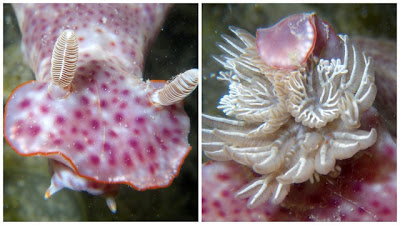
This endearing nudibranch has pretty details to look out for like its rhinophores and its gills.
There were a couple of flatworms that I've spotted including the Blue-lined flatworm (probably Pseudoceros sp.) and also this greenish one that I've never seen before. It looks like a leaf slug. Sadly, half of its body is missing. But it can still swim gracefully.
Chay Hoon also saw this really huge flounder at the bottom of the deep reef edge. Too bad I stirred up sediments so no clear photos.
The only sad part about Terumbu Raya is no sea stars sighted till now. :(
There are still a couple of echinoderms around as consolation.
Like this stonefish sea cucumber that is really big.
And this stunning red feather star that Chay Hoon again found.
Well, Terumbu Raya lives up to its name! It is indeed a great submerged reef that most Singaporeans don't know about it unfortunately. It's at our very own backyard.
This spectacular reef has many different kinds of corals which will require some time for me to write a post out of it, given my limited coral knowledge.
I have to get going with my thesis and will try to find time later to writeup the second half of today's fantastic reef experience.
Monday, March 30, 2009
The Great Reef- Terumbu Raya
Monday, March 23, 2009
My favourite cat has grown up
There are lots of adorable cats at St John's Island.
I last shared about my most favourite cat whom I named "leopard cat" because of it's stripes on the body.
In just a few months, my leopard cat has grown up so much! It seems to be fatter too..haha. Probably from our regular feeding. So pampered right?
Before (left) and After (right).
Now my darling leopard cat has not only grown bigger, but also looks cheekier. :P
Saturday, March 21, 2009
Blooming pigeon orchids
Though Singapore is well known for exporting cultivated orchids, I prefer to actually admire these pretty flowers in the wild. Recently during the week, there has been heavy downpours which of course also led to a sudden decrease of temperature.
If the decrease of temperature is at least 5.5 °C, the pigeon orchids will bloom! When they bloom, not only are they nice to look at, they also will exude strong fragrance which unfortunately last only for two days.
Pigeon orchids (Dendrobium crumenatum) are the commonest orchid in Singapore. These tropical epiphytic plants can be found growing naturally in the branches of trees. I found many pigeon orchids blooming at St John's Island a few days ago.
From the side view, the orchid resemble a flying pigeon. Therefore, they are commonly known as the Pigeon Orchid.
The pigeon orchid flower, like some other flowers, have “landing pads” at the bottom that allow insects, like bees, to fly, land and then walk in to help pollination.
The underneath of this "landing pad" or lip has a nice pale yellow colour.
This epiphytic plant has aerial roots that can help to absorb moisture from the humid air.
The stems are slender and smooth with pseudobulbs at the base.
According to Burkill, the Malays commonly use the juice of the pseudobulbs for treating ears.
The Malays poultice boils and pimples with pounded leaves. Wow!
It is known that ants of the genus Dolichoderus nest among the aerial roots of the pigeon orchid. I'm not sure the red ants here belong to that genus though. Hehe.
The next time you see pigeon orchids blooming, do stop for a moment to take a closer look at them!
Tuesday, March 17, 2009
Weird blob is a sea slug!
Remember this blob-creature found at Tanah Merah that I thought was an egg case?
It is a sea slug!
With the advice from Chay Hoon, I submitted the photos to The Sea Slug Forum for Dr. Bill Rudman to take a look.
He gave a reply within a day and that was really fast!
This sea slug is from the Philine genus. The wedge-shape and muscular body of this sea slug are modified for burrowing.
In addition to having an internal shell, it also has gizzard plates which are crushing plates in the oral cavity to feed on other molluscs. Click here to take a look at the shell and plates.
Dr Bill gives a close-up on this interesting sea slug and detailedly accounts it in his forum. Read here to learn more about this rare slug.
Glorious sunset over Pasir Ris
Last Thursday was the last evening low tide for this season till August/September. Henrietta, Samuel, Wanwei, Ze Lin and I were at Pasir Ris.
We witnessed a glorious sunset from the intertidal flat! It was a great way to end the half-year evening tide trips. It is time to welcome predawn trips where one has to drag him or herself during wee hours to catch the low spring tide.
We had some time exploring the shore and found out there were several anemones.
There are several large carpet anemones (Stichodactyla haddoni) though we couldn't find any of the delightful anemone shrimps.
To match the glorious sunset will be the peacock anemones (Order Ceriantharia).
The peacock anemones are like flowers on the shore with different stunning colours and patterns.
This weird looking stick-like thing is not a thrash stuck on the substrate but an animal. This is a sea pen and it is related to corals and anemones under Phylum Cnidaria. This sea pen is rather different from the other common ones we see on the shores as it looks like a satay stick at the top. It is likely to be a Slender sea pen (probably Virgularia sp.).
The primary polyp stiff at the centre is long and slender. At the sides are leaf-like structures without spikes on the edge.
At this shore in particular, I keep encountering this pale and skinny looking mudskipper which Ivan thinks it could be bearded mudskipper (Scartelaos histophorus). Thanks for the id Ivan.
Of course, a glorious sunset is great opportunity for a group photo! I like this photo a lot and it sort of signifies vibrancy.
Monday, March 16, 2009
Tuas and beyond
Finally the final of the four posts of the Tuesday Tuas trip. Here I will share with you all some nice landscape photos of this charming shore and beyond.
The Merawang beacon tells of its past as Pulau Merawang. I have no idea what has the island become of but judging for the GPS coordinates of the island's original location, it has been reclaimed together with Tuas. The remaining natural shore we enjoy now is what is left that belongs to the original island. A heritage that we do not want to lose forever.
Just beyond the beacon, there is an island nearby that looks like it belongs to Singapore. However it belongs to Malaysia. The shore has plentiful of nice shore and unique terraced rocky beach and Ria has done a post on this island on her wildfilms blog. I can see mangroves from this photo too!
It is heartening to know that the Save our Seahorses team is monitoring the shores over at this island. I wonder if I'll ever get a chance to take a look at this interesting island. Do click on the picture to see a larger image.
Later on, there was a thunderstorm coming from the north. The Tuas 2nd link is at the background.
At the same time, there was a spectcular sunset just round the corner towards the south!
How could these two contrasting events occur together?
This is a panoramic photo of the whole landscape connected together from seven photographs. The beauty of nature is emphasized with both storm and glorious sunset occuring at the same time as seen from Tuas shore. Click to see the larger image!
The sunet over Merawang beacon is simply breathtaking. You just can't believe this is Singapore since we are well known to be a concrete jungle. Let's hope this place stays this way!
